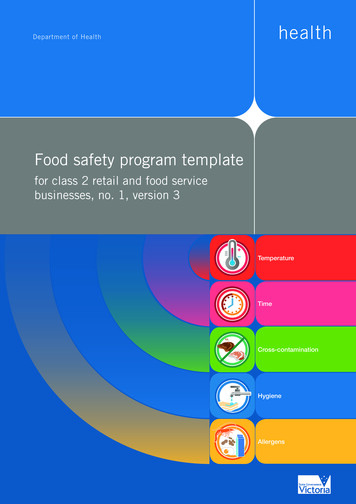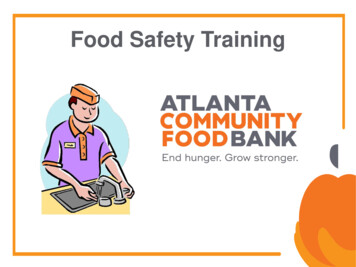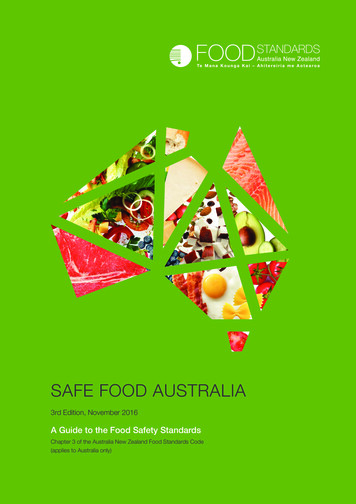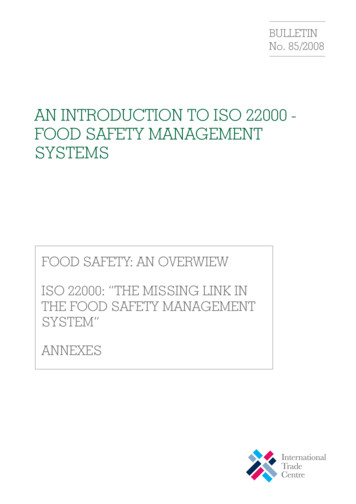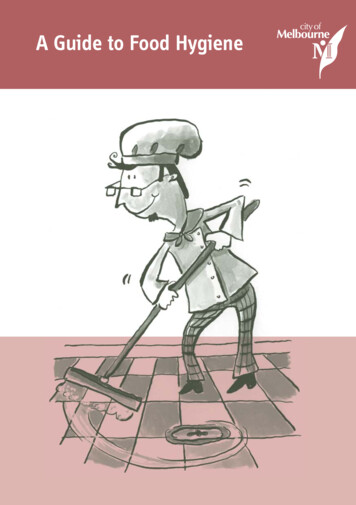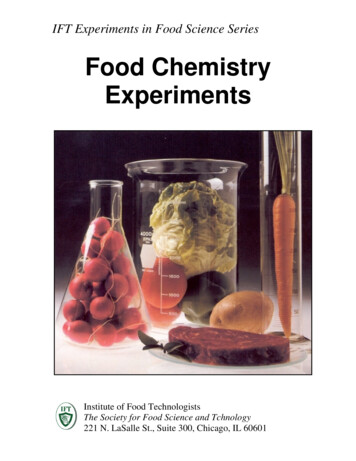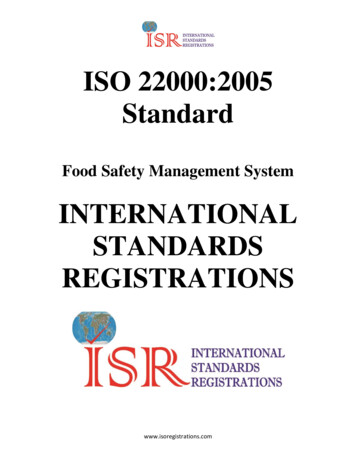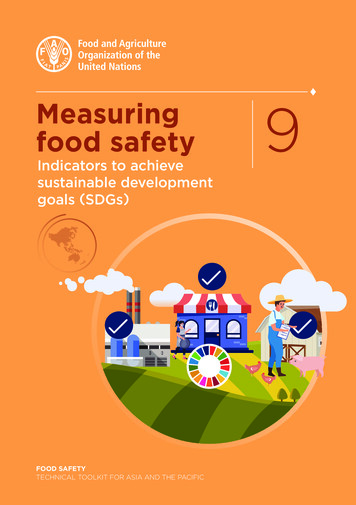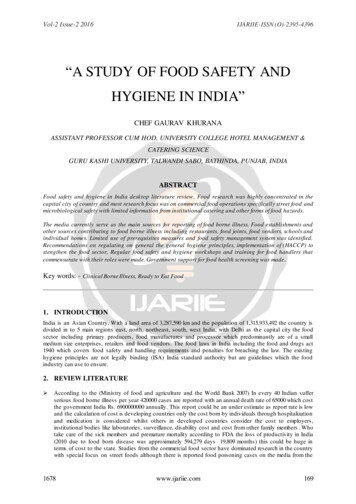
Transcription
Vol-2 Issue-2 2016IJARIIE-ISSN (O)-2395-4396“A STUDY OF FOOD SAFETY ANDHYGIENE IN INDIA”CHEF GAURAV KHURANAASSISTANT PROFESSOR CUM HOD, UNIVERSITY COLLEGE HOTEL MANAGEMENT &CATERING SCIENCEGURU KASHI UNIVERSITY, TALWANDI SABO, BATHINDA, PUNJAB, INDIAABSTRACTFood safety and hygiene in India desktop literature review . Food research was highly concentrated in thecapital city of country and most research focus was on commercial food operations specifically street food andmicrobiological safety with limited information from institutional catering and other forms of food hazards.The media currently serve as the main sources for reporting of food borne illness. Food establishments andother sources contributing to food borne illness including restaurants, food joints, food vendors, schools andindividual homes. Limited use of prerequisites measures and food safety management system was identified.Recommendations on regulating on general the general hygiene principles, implementation of (HACCP) tostengthen the food sector, Regular food safety and hygiene workshops and training for food handlers thatcommensurate with their roles were made. Government support for food health screening was made.Key words: - Clinical Borne Illness, Ready to Eat Food1. INTRODUCTIONIndia is an Asian Country. With a land area of 3,287,590 km and the population of 1,315,933,492 the country isdivided in to 5 main regions east, north, northeast, south, west India, with Delhi as th e capital city the foodsector including primary producers, food manufactures and processor which predominantly are of a smallmedium size enterprises, retailers and food vendors. The food laws in India including the food and drugs act1940 which covers food safety and handling requirements and penalties for breaching the law. The existinghygiene principles are not legally binding (ISA) India standard authority but are guidelines which the foodindustry can use to ensure.2. REVIEW LITERATURE According to the (Ministry of food and agriculture and the World Bank 2007) In every 40 Indian sufferserious food borne illness per year 420000 cases are reported with an annual death rate of 65000 which costthe government India Rs. 6900000000 annually. This report could be an under estimate as report rate is lowand the calculation of cost is developing countries only the cost born by individuals through hospitalizationand medication is considered whilst others in developed countries consider the cost to employers,institutional bodies like laboratories, surveillance, disability cost and cost from other family members . Whotake care of the sick members and premature mortality according to FDA the loss of productivity in India(2010 due to food born disease was approximately 594,279 days 19,809 months) this could be huge interms of cost to the state. Studies from the commercial food sector have dominated research in the countrywith special focus on street foods although there is reported food poisoning cases on the media from the1678www.ijariie.com169
Vol-2 Issue-2 2016IJARIIE-ISSN (O)-2395-4396institutional setups specifically schools. In 2012 reported that a study on microbiological food safety is oneon the decline and highly centred in the capital city in the country. Although all food hazards aredetrimental to the health of consumers and require monitoring and the control in the country, currentlymicrobiological hazards in ready to eat foods and comical hazards mostly pesticides from agricultureproduct including fresh vegetable and fruits have been highlighted(Amoah, Abaidoo, & Ntow,2006;Bempah, Donkor, Agei, Buah-Kwofie, & Boateng, 2011; Feglo &Sakyi, 2012; Mensah, Yeboah Manu, Owusu-Darko, & Ablordey,2002). There is minimal information on physical contaminants / hazards,food allergy and injuries caused by these. This could be due to less awareness and or lack of publiceducation of these hazards. The FAO/WHO, 2005 regional report on food safety for Africa recordedmicrobiological hazards as the most eminent risk from street foods but also reported the danger of highlevels of heavy metals including lead, cadmium, arsenic, mercury and copper and also pesticide residuesfrom utensils, raw materials or transport methods used. This work looks at food safety and hygiene report inIndia. Desk top review of literature was carried out. Search was conducting using mainly Google search enginewith phrases including „food safety in India‟ food hygiene in India. Food hygiene training India and list offood poisoning in India journals used includes food control, internet journal of food safety. Food andnutrition science, food and public health, food science and technology, journal of infection in developingcountries, journal of urban health and Africa journal of food agriculture nutrition and developmentprofessional sites included world health organisation (WHO), India health service and oxford library. Mediasources were used for individual case of food poisoning in homes, commercial and institutional setup. Dataused range from 1999 to 2013. Report from media and scholarly research articlesTable: 2.1Two in every 10 food samples tested for quality over the past year have been found to be either adulterated ormisbranded, revealing alarming trends in the country‟s food safety sector. What‟s worse, conviction rate in thesecases of poor food quality has been less than 10 per cent, meaning only one in every 10 cases of foodadulteration and misbranding are ending in convictions.These trends are contained in the Food Safety and Standards Authority of India (FSSAI)‟s Annual PublicLaboratory Testing Report 2014-2015, which shows that food testing labs under the regulatory networkanalysed 74,010 food samples for quality and mandatory health disclosures over the past year and found 14,599of these either adulterated or misbranded. This implies 20 per cent of all samples failed the test of quality andbranding regulations.1678www.ijariie.com170
Vol-2 Issue-2 2016IJARIIE-ISSN (O)-2395-4396 Research Reports From Food Scientist In The CountryFood hygiene practices among food handlers, mostly food vendors and catering services have been reportedto br below standard ((Addo, Mensah, Bonsu, & Akyeh, 2007; Afoakwa, 2005; Feglo &Sakyi, 2012;Tomlins et al., 2002).Hospitality industry has been around hotels, restaurants, and street food vendors mostly in the capital city.High levels of total bacterial counts in street food beyond the acceptable reference figures 105 ColonyForming Units (CFU) g 1 set by the Indian Standards Authority for Ready to Eat Foods. The food safetyand standards authority of India (FSSAI) is an agency of the ministry of health and family welfare,government of India. The FASSI is responsible for protecting and promoting public health though theregulation and supervision of food safety. The FSSAI has been established under the food safety andstandards Act, 2006 which is a consolidating statute related to food safety and regulation in India. The FASSAI is led by a non –executive chairperson appoint by the central government from among st thepersons of eminence in the field of food science or from amongst the person from the administration whohave been associated with the subject and is either holding or has held the position of not below the rank ofsecretary to the government of India. Mr. Ashish Bahuguna is the current chairperson. The FSSAI has itsheadquarters at New Delhi the agency also has 8 regional offices located in Delhi, Chandigarh, Lucknow,Guwahati, Mumbai, Kolkata, Cochin and Chennai.3. OBJECTIVE OF THE STUDY1.2.To study about the clinically borne illness disease in food hygiene.To study and analysis about the ready to eat food under the food safety.4. RESEARCH METHODOLOGYMy Project Report is basically based on Exploratory Research Techniques as I have worked on alreadyexisting data. In this report I have evaluate and analysis the data to get the conclusion when are based onexiting data.5. ANALYSIS AND INTERPREATATION5.1 Clinical Borne IllnessFood safety the food and drugs authority (FDA) is a national regulatory body under the ministry of health withthe responsible of implementing food polices and ensuring the safety and wholesomeness of food forconsumers ( FDA) Roles including food manufacturing and processing site inspection, licens ing, productregistration and monitoring they also provide good hygiene. Practise training for food handlers. The Indiastandard author develops and promotes international and locally acceptable standards for the industry. Othersporting agencies including the ministry of health, ministry of health agriculture, Indian tourist board and theenvironment agency. The government of India is also given directives to the local authorities includingmetropolitan assemblies and their districts to actively control an d monitor food safety practise of food vendors.Who are individual or group of people who sell ready to eat food at readily accessible areas including caterers,night club, beer bars, chop bars, cold store, hotels and restaurants operations and bagged wate r processors.Fig: 5.1.1The water and food hygiene unit of the environmental health department of the districts is responsible for thehealth monitoring and certification of food vendors. This is subject to renewal on a yearly basis world healthorganisation report of high levels of diarrhoeal cases of which a higher percentage are due to food and waterborne infections1678www.ijariie.com171
Vol-2 Issue-2 2016IJARIIE-ISSN (O)-2395-4396Table of Clinical Borne IllnessDiarrhea , Nausea or VomitingSymptomatic Treatment: ORSAssess duration (if 1 day)And severity (if high)HistoryDurationFeverStool AppearanceCommon SourcesAntibiotic useTravel and obtain stool for M/ETable: 5.1.15.2 Ready to eat (RTE) food and processed foods with needed controlSelected food for hazards analysis by research revealed varying microbiological contamination levels (addo et al.2007 feglo and sakyi 2012 tomlins 2013) food from hotels sampled in Delhi showed acceptablelevels whiles street food from the same city had detectable levels of enteric pathogens. Kenkey due to lowPH was reported to be a low risk food in terms of microbial load (cooked rice and beans mixed) had asimilar report but both could be contaminated with lead above the acceptable levels of 0.2 mg/kg due tousage of informally manufactured pots that could have lead levels as high as 419 mg/kg causing cumulativeharm. Fufu due to its method of preparation had Escherichia coli and detectable staphylococcus (bacteria)aureus. Similar reports were made on high risk street foods in Delhi. Food studies including ice kenkeycoca cola, fufu, ready to eat food, red pepper sauces , salad, and pasta. All had plate count level above theacceptable national standard of 5.0 log10 cfu/ml (Feglo & Sakyi, 2012). Enteric bacterial were alsoisolated.5.3 Some Recommendation from Research out PutTraining of personnel in food safety and hygiene was highly recommenda tion across board. Training is afundamental requirement for food safety management system and it is legal requirement.Table of Selected Food research articles and recommendationsAuthorsTortoe et al.Year2013TitleSystematic Approachfor theManagement andcontrol offood safety for thestreet/informal food sectorin GhanaFeglo and Saky2012Johnson et al.2008Bacterialcontamination ofstreet vending foodin Kumasi,GhanaA case study to1678Finding and recommendationModules developed for RTEstreet foods in Accra.Microbiological survey showedthat some street foodsare intrinsically safer than othersthus requiringSystems of control. Intensifiedtraining of street foodvendors and consumers createdawareness of therelationship betweencontaminated food and fooddiseaseMost ready to eat food arecontaminated with entericbacteria and other pathogens athigher levels thanAcceptable.Food safety management basedwww.ijariie.comJournalFood and PublicHealth. 2013,3(1):59e67Journal of medicalandBiomedicalSciences(2012)Internet Journal of172
Vol-2 Issue-2 2016Saba andGonzalez-ZornIJARIIE-ISSN (O)-2395-43962012develop anappropriate qualityassurancesystem for twocassava-basedconvenience foods inUKMicrobial foodsafety in GhanametaAnalysison the HACCPprinciples is applicable to foodprocessing industry inUK and HACCP Plan wascontingent on addressingFood Safety,Vol. 10. 2008 p81e84Microbiological foodcontamination in Ghana wasalarming. There was adownward trend in research inmicrobiological food safety anda concerted effort in thisarea was needed in Ghana tohelp curb the incidence ofpreventable food-borne diseaseJournal of Table: 5.3.15.4 Reported Ready to eat (RTE) food types and style of preparation locally.Food typeKenkeyIngredientsCorn doughHow preparedSemi cooked corn dough shapedin corn husk/plantain leaves and boiledWaakyeRice and beansCocoa drinksCocoa powderand sugarPepper, onion,salt and tomatoSaladLeaves, freshvegetablesMacaroniWheat flourRice added to pre boiledbeans/cowpea andboiled until softMixture of cocoa powder andwater; no boilingGrinding in public disc attritionmills or locallymade clay grindersWashed with water and cut intodesired shapesand sizes with knives or handBoiledFresh fruit juiceIndividual ormixed fresh fruit,water and sugarWashed, peeled and milled withadded waterand sugarRed pepper sauceHow servedMostly hot and intact inlocal packaging(corn husk/plantainleaves)With ladles or hands offood handlerPackaged into polythenebags by handServed with spoonServed with spoon orhandServed with spoon orhandPoured into cups orbottles by handTable: 5.4.15.5 Possible support and interventions for IndiaThe food industry is only as strong as its weakest link in the food chain (Taylor, 2001).The food industry in every nation whether developed or not stand to lose if all stages in the food chain are notmotivated and strengthened to use food safety approaches. The benefits of reducing hazards in food includereduced morbidity, mortality and demands on healthcare services, a reduction in absences from education or lossof productivity at work and increased consumer confidence in food safety (Food Standards Agency, 2011). TheIndia efforts listed below could strengthen the food services and manufacturing sectors to become competitivewhiles ensuring consumer safety.i.Continuous sensitization programmes for food handlers and consumers along the food chain of theirroles on compliance with food safety requirements.ii.Good Hygiene Practices which are mostly called Prerequisite measures to be available and enforcedas the basic requirement for food industries and vendors. These include the establishment of thefollowing; process and facility design to acceptable standards, personal hygiene of food handlerswhich include effective hand washing, use of protective clothing, reporting and proper handling ofinfectious diseases including diarrhoea and vomiting, absence of jewellery/ self-adornment duringpreparation and service etc, cleaning procedures for both equipment and food environment, waste1678www.ijariie.com173
Vol-2 Issue-2 2016IJARIIE-ISSN (O)-2395-4396management, pest control, routine training programmes for staff, planned preventive maintenance andtransport, supplier and raw material monitoring and control, process control and temperaturemonitoring (WHO/FAO, 2009). These when available creates a safe and conducive environment forthe processing and or preparation of food.iii.HACCP which is a more flexible. Industry specific food safety tool could be made a legalrequirement for manufacturing and processing industries with a given period whit in which absencecould be a breach of the national law. This will help to raise the standard of operations and practicesof the food industry in India to an International level (FAO/WHO, 2009), enabling them to competein the international market.Fig: 5.5.1Small and Medium Size Enterprises (SMEs) support systems could be initiated by the Government'sappropriate agencies and educational institutions to help them establish acceptable food safetymanagement systems. Government and local authority's intervention in the form of free or subsidizedtraining, developed food safety standards by (2008) referred to its use as contingent in addressingfood safety constraints in the country. Rheinlander et al. (2008) reported of the need to include goodhand hygiene and cleanliness of kitchen facilities and environment in training programmes asconsumers current risk avoidance strategy of looking at appearance of food, food stands andtrustworthiness of food vendors were not enough to protect them from food borne diseases.iv.CONCLUSIONThe food industry as reported by researches has more room for improvement. Good hygieneprinciples need to be regulated and enforced. There is a need for introduction of standards,development on food safety management system that are suitable for the loca lity with continuous andintensive workshops for food handlers. Small and medium size enterprises require governmentspecial intervention in from on sponsored training publicity and other means of awareness creationthere is also the need for increased public awareness on good hygiene and food safety practices thatconsumers should look out for apart from aesthetic attributes this will increase demand for qualityand safe food, a driving force that has pushed food safety and quality system up in developedcountries research in various regions and sector of the food industry was in adequate and more shouldbe done. Every nation has regulations that are supposed to protect its people against unsafe practisesin food production, and the existing agencies needs to be equipped to change control.REFERENCESi.ii.iii.iv.v.vi.vii.1678Ababio, P. F., & Adi, D. D. (2012). Evaluating food safety practices among foodhandlers in the Kumasi Metropolis. Internet Journal of Food Safety, 14, 35e43.Ababio, P. F., Adi, D. D., & Commey, V. (2012). Food safety management systems, availabilityand maintenance among food industries in Ghana. Food Science and lson, P., Forbes, P. M., & Hall, G. (2006). The annual cost of food borne illness in Australia.Common Wealth of Australia, 1e108. www.ag.gov.au/cca.Ackah, M., Gyamfi, E. T., Anim, A. K., Osei, J., Hansen, J. K., & Agyeman, O. (2011). Economicprofile, knowledge of hygiene and food safety practices among streetefood vendors in some partsof Accra- Ghana. Internet Journal of Food Safety, 13, 191e197.Addo, K. K., Mensah, G. I., Bonsu, C., & Akyeh, M. I. (2007). Food and its preparation conditionsin hotels in Accra, Ghana. A concern for food safety. African Journal of Food AgricultureNutrition and Development, 7(5).Afoakwa, E. O. (2005). Enhancing the quality of school feeding programs in Ghana. Unpublishedarticle. Legon: Department of Nutrition and Food Science.Ministry of Food and Agriculture/World Bank. (2007). Review of food safety inwww.ijariie.com174
Vol-2 Issue-2 2016viii.ix.x.1678IJARIIE-ISSN (O)-2395-4396Ghana. www.worldbank.org. Viewed 14/10/12.WHO. (1997). Pesticides residues in food: 1997 evaluations. Geneva, Switzerland:World Health Organisation Expert Group On Pesticides Residues. December 6e15, 1997.www.ijariie.com175
Food safety and hygiene in India desktop literature review. Food research was highly concentrated in the . Journal of medical and Biomedical Sciences(2012) Johnson et al. 2008 A case study to Food safety management based Internet Journal of . Saba and in . Vol-2 Issue-2 2016 IJARIIE -ISSN (O) 2395 4396 .

